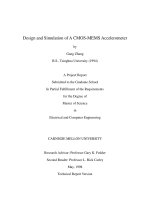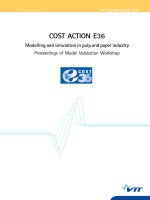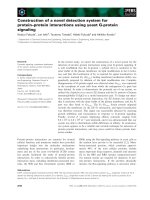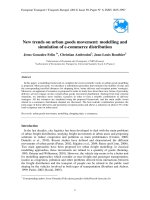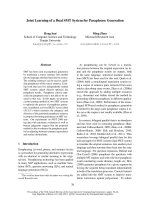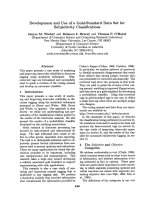Modelling and simulation of a conveyor belt system for optimal productivity
Bạn đang xem bản rút gọn của tài liệu. Xem và tải ngay bản đầy đủ của tài liệu tại đây (492.47 KB, 7 trang )
International Journal of Mechanical Engineering and Technology (IJMET)
Volume 11, Issue 1, January 2020, pp. 115-121, Article ID: IJMET_11_01_012
Available online at />ISSN Print: 0976-6340 and ISSN Online: 0976-6359
© IAEME Publication
MODELLING AND SIMULATION OF A
CONVEYOR BELT SYSTEM FOR OPTIMAL
PRODUCTIVITY
Ganiyat Salawu
Department of Mechanical Engineering
University of KwaZulu-Natal, Durban, South Africa
Glen Bright
Department of Mechanical Engineering
University of KwaZulu-Natal, Durban, South Africa
Chiemela Onunka
Department of Mechanical Engineering
Mangosuthu University of Technology, South Africa
ABSTRACT
The productivity level in an advanced manufacturing environment can be
improved by proper design of mechanism at the initial stage in the manufacturing
system. The aim of this paper is to model and simulate the design parameters of a
conveyor system that transport parts from one production stage to another. The
approach of model-based design and simulation was used to achieve optimal
efficiency of conveyor belt during its operation. Working parameters that can
determine the measurable performance of conveyors were studied and presented in a
classical model. Outcome from the analysis were simulated using MATLAB software.
Simulation results shows that the design parameters used, gave an optimal operating
speed at a reduced time of operation.
Keywords: Conveyor system; component; Modelling; Simulation; Efficiency.
Cite this Article: Ganiyat Salawu, Glen Bright and Chiemela Onunka, Modelling and
Simulation of a Conveyor Belt System for Optimal Productivity. International Journal
of Mechanical Engineering and Technology 11(1), 2020, pp. 115-121.
/>
1. INTRODUCTION
This work presents a classical model that can be adopted in an early stage of manufacturing
when a conveyor belt design is required for optimal productivity. Proper material handling in
industries is an important area that requires improvement in order to regulate overall
production cost. Higher efficiency of the conveyor belt assists manufacturers to obtain higher
productivity during manufacturing and material handling stages [1]. Conveyor belts is
common in an advanced manufacturing environment for transportation of raw materials from
/>
115
Ganiyat Salawu, Glen Bright and Chiemela Onunka
initial stage to finished products stage [2]. A simple diagram of the conveyor belt system is
given in Figure 1. The different components of a belt conveyor system are mainly the electric
drives, pulleys, idlers, and a long belt. The energy consumption of a conveyor belt can add up
to the expenditure in manufacturing industries and lead to an increase in operating cost [3].
The on-going drive among competitors in manufacturing industries requires effective design
that can lower the utilization of operating resources [3] [4] [5]. Therefore, a design that can
reduce power utilization is required to lower the overall cost of production.
Load
Figure 1: Typical diagram of a conveyor belt system
Previous works has been done to study the conveyor system efficiency using various
approach. Shirong and Xiaohua carried out a research to improve the energy efficiency of
conveyor belt system by using modelling and optimization approach. The analytical
modelling was initiated to describe the stages involved in its operation. Various parameters
assumed to represent the conveyor operation were simulated and optimized to achieve the best
operating efficiency (Shirong, 2011). In the work of Irfan and Sania, the energy efficiency of
conveyor system was studied by considering various factors that contributes to the cost of
electricity of a conveyor system. Different stages involved were modelled by considering the
driving speed when it was fully loaded, partially loaded and when there was no load on it.
This enabled them to come up with a relationship between the speed of the conveyor belt, belt
loading dynamic, and rate of power consumed during conveyor system operation [7].
Energy reduction has been a major area of concern to recent researchers. This will assist
manufacturers to reduce cost of manufactured parts. An attempt to control energy
consumption of a conveyor system was also a success in the work of Halepoto et al. The cost
of electricity in electrically and mechanically driven components of conveyor system was
evaluated by controlling the multiple drive system of the mechanism. This enable adequate
evaluation and integration of some factors that might lead to high consumption rate of
electricity [8]. A dynamic model developed was suitable for comparing the behavior of the
driving mechanism of a conveyor belt. Outcome from simulation effectively analyzed the
relationship between the dynamic behavior of a multiple driven conveyor system and a single
conveyor system [9].
Weight is also a design factor to be considered when designing a conveyor system. In [10]
[11], a roller belt conveyor system was redesigned for weight reduction. The optimization of
an existing roller was carried out whereby the C-channel that serves as the support for the
chassis was re-designed, and Modelled using the ANSYS software. The re-designed chassis
gave a roller conveyor with minimal weight [11]. The evaluation of materials for the design
of conveyor belt requires the selection of a standard design parameters that can be cost
effective, durable and can be able to withstand load above its limit [3].
Sustainability is also an important factor to be considered when designing conveyor
system. The conveyor system must be able to sustain any environmental factor without
affecting its operations. The approach to optimize the design of a conveyor system lead to a
more effective manufacturing by reducing cost of manufacturing. A suitable design was
/>
116
Modelling and Simulation of a Conveyor Belt System for Optimal Productivity
selected for the conveyor chain. The design adequately reduced the energy consumed during
the service condition of the conveyor system [6]. In [12], speed control of conveyor belt can
reduce its energy consumption. Effective control and simulation or system analysis produces
an optimum acceleration time [12]. The rapid growth of technology required conveyor design
that can satisfy transportation of any kind of material. Parameters such as the shaft pitch,
number of rollers incorporated were studied to enable the conveyor belt to properly handle
glass materials of different sizes [13]. A composite system for a conveyor line speed was
designed and modelled. The controller was effective to solve some existing manufacturing
problem [14]. Furthermore, an adaptive observer was effectively implemented in estimating
some unknown parameters of a conveyor belt system. The model developed gave a reliable
output when it was used to measure the angular velocity of a rotor that drives a DC motor as
well as the feed rate of the conveyor belt system [15]. Different methods of transporting
materials exist in manufacturing industry, but the use of conveyor belt has been one of the
most common and efficient means of transporting materials and parts from one manufacturing
stage to another [16]
A. The need for proper selection of parameters is a factor that determines its efficiency. In
this present study, a conveyor belt system that can operate below and above rated speed was
considered. The effect was studied by using notable parameters to generate equations that
were solved using engineering equation solver. Outcome were simulated using MATLAB
software and optimal values that can give us suitable design parameters were selected and
illustrated graphically in graph of Figure 2 and 3.
2. DESIGN MODEL FOR THE CONVEYOR SYSTEM
The model considers the design of a conveyor belt mechanism that can operate under varying
loads within a reduced operating time. The conveyor belt is assumed to be operating within a
speed reduction loss of 5%. Considering the design parameters and notation, an operating
conveyor system with optimal efficiency was developed.
3. DESIGN CONSIDERATION
This model considers the application of conveyor belt system that transports materials and
goods from one manufacturing stage to the other. During operation, the conveyor belt
experiences a tensile effect as a result of the weight of the loads that passes through it. These
loads can be categorized into:
Load due to the conveyed materials
Load due to the idler that guides the belt movement
Load due to the rotational effect of the belt drives
The design of a conveyor belt system must consider proper selection of idler type. The
selection considers the optimum weight carrying capacity so as to have a design that will not
fail during operation. Equation 1, can be used to calculate for the idler load.
(1)
Also, the load due to the conveyed materials is also part of the factors that would be used
when the tensile effect is required to be calculated. It can be expressed as the ratio of the
capacity of the conveyor to the speed of the rotating belt as given in equation 2.
(2)
/>
117
Ganiyat Salawu, Glen Bright and Chiemela Onunka
The tension of the conveyor belt can be evaluated by considering the friction co-efficient
, length and height of the conveyor (
), acceleration due to gravity ( ), inclination angle
, and the three loading effects. This can be calculated using the equation below
Two different power are required during the movement of materials on a conveyor belt.
The power that drives the pulley and the minimum power required to drive the electric motor.
Equation 4 and 5 was developed for the design calculation of the power required to drive the
conveyor belt mechanism.
represents the power required to drive the pulley and can be
calculated using equation 4, and the minimum power required to drive the electric motor can
be obtained using equation 5.
(4)
Consequently, the conveyor belt acceleration can be obtained using equation 6.
(6)
Furthermore, the operating time can be calculated using
(7)
The speed of rotation of pulley was calculated using equation 8.
Total motor horse power
was obtained with the addition of equation (4) and (5). A
speed reduction of 5% was considered to take care of losses.
The motor current can be calculated by considering the total horse power to the ratio of
voltage required, efficiency, and the power factor as stated in equation 10.
The tensile stress experienced when the conveyor belt is in the steady state can be
obtained using equation 11.
)
Consequently, the conveyor belt acceleration can be obtained using equation 12
3.1. Selected Notations for the Design
/>
118
Modelling and Simulation of a Conveyor Belt System for Optimal Productivity
(kw)
T = Ambient temperature
Using the set of derived equations above, values were assumed for some of the design
parameters, and solved using the engineering equation solver (EES). Results obtained is given
in Table 1:
Table 1: Design parameters for the conveyor belt
0.80
20kg
9.81
G
/>
119
Ganiyat Salawu, Glen Bright and Chiemela Onunka
4. RESULTS AND DISCUSSION
The graph of figure 2. Shows the relationship between the operating speed of an electric
motor and the operating time of the conveyor belt drive. There is a reduction in the time spent
during operation as the driving speed increases. Also, Figure 3, shows the relationship
between the power consumption and time of operation, this operating condition is suitable and
efficient in an advanced manufacturing environment.
700
Operating Speed
600
500
400
300
200
100
0
0
0.1
0.2
0.3
0.4
0.5
Operating time
Figure 2. Graph of operating speed against time
17000
y = 14.655x + 6937.2
R² = 1
power consumption in Watt
16000
15000
14000
13000
12000
11000
10000
9000
200
300
400
500
600
700
Operating Speed in m/s
Figure 3. Power consumption VS Operating speed
5. CONCLUSION
In previous studies, focus is mainly on how to regulate the conveyor belt with the loads
designed for its operation. In this present study, A classical model was designed with some
assumed parameters, to study the effect of varying the loads below and above the rated speed
of electric motor. Equations were developed using some notations to represent operating
parameters of a conveyor belt manufacturing system. MATLAB software was adopted to
build simulic mathematical equations and solved using the engineering equation solver (EES).
Results obtained were simulated to obtain and select suitable results that gave us optimal
design parameters. This enabled proper prediction of optimal operating conditions. For the
selected machine, at 390m/secs, the optimal operating time is 0.4secs at a power consumption
/>
120
Modelling and Simulation of a Conveyor Belt System for Optimal Productivity
of 12700W. This proves that the design is suitable when an optimal time for a conveyor speed
is required to be selected. Most focus has been on increasing efficiency of conveyor belt
system. Thermal analysis of the conveyor belt materials is a good area for further studies.
ACKNOWLEDGMENT
The financial supports from the TETFUND Nigeria through the federal polytechnic offa,
Kwara state Nigeria, (TETFUND/DAST$D/POLY/OFFA/ASTD/2017/VOL 1) is highly
acknowledged.
REFERENCES
[1]
[2]
[3]
[4]
[5]
[6]
[7]
[8]
[9]
[10]
[11]
[12]
[13]
[14]
[15]
[16]
S. S and P. A. Vanamane, "Design, Manufacture and Analysis of Belt Conveyor System
used for Cooling of Mould," International Journal of Engineering Research and
Applications (IJERA), vol. 2, no. 3, pp. 2162-2167, 2012.
N. D.K, "Design and optimization of roller conveyor system," International journal of
science and engineering research, vol. 5, no. 7, 2014.
K. N.S.A, V. R and P. K.W, "Design and Selecting the Proper Conveyor-Belt,"
International Journal of Advanced Engineering Technology, vol. 4, no. 2, pp. 43-49, 2013.
M. S.M, L. Z and X. X, "A Comparative Study on the Cost-effective Belt Conveyors for
Bulk Material Handling," Energy Procedia, vol. 142, p. 2754–2760, 2017.
S. T. &. M. R, "Design of Belt Conveyor System," International Journal of Science,
Engineering and Technology Research (IJSETR), vol. 7, no. 7, pp. 2278 -7798, 2018.
Z. &. X. X. Shirong, "Modeling and Energy Efficiency Optimization of Belt Conveyors,"
Applied energy, vol. 88, no. 9, pp. 1-11, 2011.
A. &. S. K. Irfan, "Modeling of an Integrated Energy Efficient Conveyor System Model
using Belt Loading Dynamics," Indian Journal of Science and Technology, vol. 9, no. 47,
pp. 1-6, 2016.
[H. I.A, S. M.Z, C. B.S and U. M.A, "Design and Implementation of Intelligent Energy
Efficient Conveyor System Model Based on Variable Speed Drive Control," International
Journal of Control and Automation. , vol. 9, no. 6, pp. 379-388, 2016.
T. I. S. &. L. S. A., "The Efficiency Improvement of Belt Conveyor Intermediate Drive
Traction Effort," ARPN Journal of Engineering and Applied Sciences, vol. 11, no. 7, pp.
4317-4321, 2016.
V. R.S, S. P, S. C.V, A. M and B. P, "Design and Optimisation of Roller Conveyor
System," International Journal of Mechanical Engineering and Technology, vol. 9, no. 4,
pp. 116-125, 2018.
P. J, D. D and P. S., "Design and Optimization of Roller in Belt Conveyor," International
Journal of Mechanical and Production Engineering, vol. 5, no. 7, pp. 34-37, 2014.
D. H, Y. P and G. L, "Determination of acceleration for belt conveyor speed control in
transient operation," International journal of engineering and technology, vol. 8, no. 3, pp.
206-211, 2016.
S. P and K. P, "Design optimization of conveyor rollers arrangement for stable flat pernel
display (FPD) glass transfer," Journal of Mechanical Science and Technology, vol. 32, no.
7, pp. 3241-3248, 2018.
U. M. A, E. A.O and E. I.I, "Design and Implementation of Conveyor Line Speed
Synchroniser for Industrial Control Applications: A Case Study of Champion’s Breweries
Plc, Uyo," Nigerian Journal of Technology (NIJOTECH), vol. 35, no. 3, pp. 618-626,
2016.
Y. S. &. X. X., "Adaptive Parameter Estimation for an Energy Model of Belt Conveyor
with Dc Motor," Asian Journal of Control, Vol, vol. 16, no. 4, p. 1122–1132, 2014.
M. B and L. R, "Speed Controlled belt Conveyors: Drives and Mechanical Consideration,"
Advances in Mechanical and Computer Engineering, vol. 18, no. 11, pp. 51-60, 2018.
/>
121

